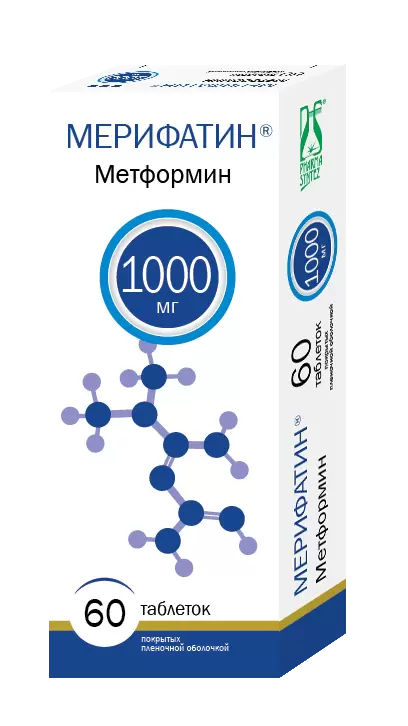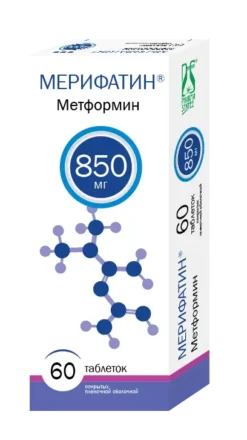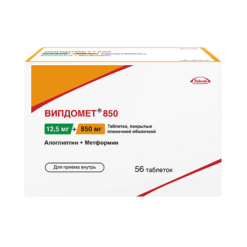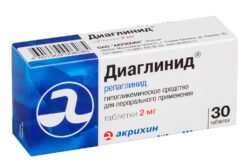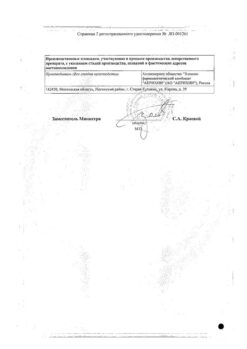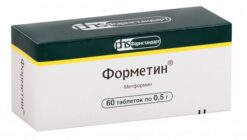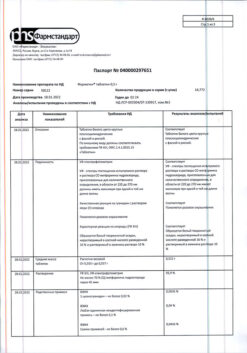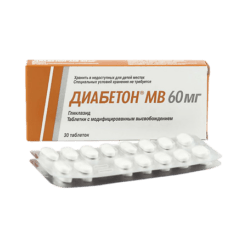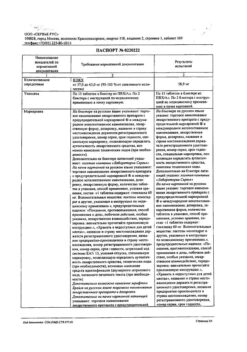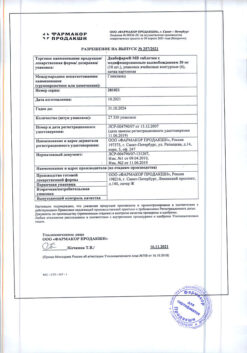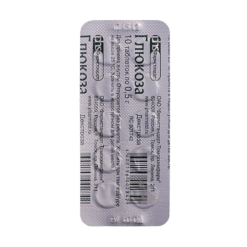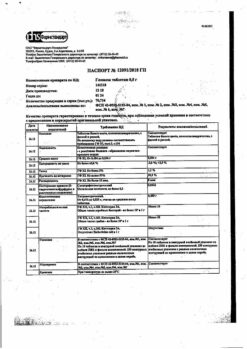No products in the cart.
Merifatin, 1000 mg 60 pcs
€5.37 €4.77
Description
Hypoglycemic agent of the group of biguanides for oral use.
Indications
Indications
Type 2 diabetes mellitus, especially in obese patients, with ineffective diet therapy and exercise:
• in adults as monotherapy or in combination with other oral hypoglycemic agents or insulin;
• in children over 10 years of age as monotherapy or in combination with insulin.
Prevention of type 2 diabetes mellitus in patients with prediabetes with additional risk factors for developing type 2 diabetes mellitus in whom lifestyle changes have not allowed them to achieve adequate glycemic control.
Pharmacological effect
Pharmacological effect
Hypoglycemic agent of the biguanide group for oral use.
Special instructions
Special instructions
Duration of treatment
Metformin should be taken daily, without interruption. If treatment is stopped, the patient must inform the doctor.
Active ingredient
Active ingredient
Metformin
Composition
Composition
1 tablet contains:
Active ingredient:
metformin hydrochloride 1000 mg.
Excipients:
hypromellose 2208 10.0 mg;
povidone K90 (kollidon 90F) 40.0 mg;
sodium stearyl fumarate 10.0 mg.
Film water-soluble coating:
hypromellose 2910 14.0 mg; polyethylene glycol 6000 (macrogol 6000) 1.8 mg; polysorbate 80 (Tween 80) 0.2 mg; titanium dioxide 4.0 mg.
Contraindications
Contraindications
• Hypersensitivity to metformin or to any excipient;
• diabetic ketoacidosis, diabetic precoma, coma;
• renal failure or impaired renal function (creatinine clearance less than 45 ml/min);
• acute conditions with a risk of developing renal dysfunction: dehydration (with diarrhea, vomiting), severe infectious diseases, shock;
• clinically pronounced manifestations of acute or chronic diseases that can lead to the development of tissue hypoxia (including 4 acute heart failure, chronic heart failure with unstable hemodynamic parameters, respiratory failure, acute myocardial infarction);
• extensive surgical operations and injuries, when insulin therapy is indicated (see section “Special Instructions”);
• liver failure, liver dysfunction;
• chronic alcoholism, acute alcohol poisoning;
• pregnancy;
• lactic acidosis (including history);
• use for less than 48 hours before and within 48 hours after radioisotope or x-ray studies with the introduction of an iodine-containing contrast agent (see section “Interaction with other drugs”);
• adherence to a hypocaloric diet (less than 1000 kcal/day).
With caution
Apply the drug
• in people over 60 years of age who perform heavy physical work, which is associated with an increased risk of developing
them lactic acidosis;
• in patients with renal failure (creatinine clearance 45-59 ml/min);
• during breastfeeding.
Side Effects
Side Effects
The frequency of side effects of the drug is assessed as follows: very often (≥1/10); often (≥1/100, <1/10); uncommon (≥1/1000, <1/100); rare (≥1/10000, <1/1000); very rare (<1/10000).
Side effects are presented in order of decreasing importance.
Metabolism and nutrition: very rarely – lactic acidosis (see “Special Instructions”). With long-term use of metformin, a decrease in the absorption of vitamin B12 may be observed. When megaloblastic anemia is detected, the possibility of such an etiology must be taken into account.
From the nervous system: often – taste disturbance.
From the gastrointestinal tract: very often – nausea, vomiting, diarrhea, abdominal pain, lack of appetite. Most often they occur during the initial period of treatment and in most cases resolve spontaneously. To prevent symptoms, it is recommended to take metformin 2 or 3 times a day with or after meals. Slowly increasing the dose may improve gastrointestinal tolerability.
From the skin and subcutaneous tissue: very rarely – skin reactions such as erythema, itching, rash.
Disorders of the liver and biliary tract: very rarely – abnormal liver function tests or hepatitis; after discontinuation of metformin, these adverse effects completely disappear.
Published data, post-marketing data, and controlled clinical studies in limited pediatric populations aged 10-16 years indicate that side effects are similar in nature and severity to those observed in adult patients.
Interaction
Interaction
Contraindicated combinations
Iodine-containing radiocontrast agents: against the background of functional renal failure in patients with diabetes mellitus, radiological examination using iodine-containing X-ray contrast agents can cause the development of lactic acidosis. Treatment with metformin should be discontinued depending on renal function 48 hours before or during an X-ray examination using iodinated contrast agents and not resumed earlier than 48 hours after, provided that during the examination renal function was found to be normal.
Not recommended combinations
Alcohol: with acute alcohol intoxication, the risk of developing lactic acidosis increases, especially in the case of:
• malnutrition, low-calorie diet;
• liver failure.
While taking the drug, you should avoid drinking alcohol and medications containing ethanol.
Combinations requiring caution
Danazol: simultaneous use of danazol is not recommended to avoid the hyperglycemic effect of the latter. If treatment with danazol is necessary and after discontinuation of the latter, a dose adjustment of metformin is required under the control of blood glucose concentrations.
Chlorpromazine: When taken in large doses (100 mg per day), it increases blood glucose concentrations, reducing insulin release. When treated with antipsychotics and after stopping the latter, dose adjustment of the drug is required under the control of blood glucose concentration.
Glucocorticosteroids (GCS) of systemic and local action reduce glucose tolerance, increase the concentration of glucose in the blood, sometimes causing ketosis. When treating GCS and after stopping the latter, dose adjustment of metformin is required under the control of blood glucose concentration.
Diuretics: Concomitant use of loop diuretics may lead to the development of lactic acidosis due to possible functional renal failure. Metformin should not be prescribed if creatinine clearance is below 60 ml/min.
Prescribed by injection, beta2-adrenergic agonists: increase the concentration of glucose in the blood due to stimulation of beta2-adrenergic receptors. In this case, monitoring of blood glucose concentration is necessary. If necessary, insulin administration is recommended. When using the above drugs simultaneously, more frequent monitoring of blood glucose may be required, especially at the beginning of treatment. If necessary, the dose of metformin can be adjusted during treatment and after its cessation.
Antihypertensive drugs, with the exception of angiotensin-converting enzyme inhibitors, can reduce blood glucose concentrations. If necessary, the dose of metformin should be adjusted. When metformin is used simultaneously with sulfonylurea derivatives, insulin, acarbose, and salicylates, hypoglycemia may develop.
Nifedipine increases absorption and Cmax of metformin.
Cationic drugs (amiloride, digoxin, morphine, procainamide, quinidine, quinine, ranitidine, triamterene, trimethoprim and vancomycin) secreted in the renal tubules compete with metformin for tubular transport systems and can lead to an increase in its Cmax.
Overdose
Overdose
When using metformin in a dose of up to 85 g (42.5 times the maximum daily dose), no hypoglycemia was observed. However, in this case, the development of lactic acidosis was observed. Significant overdose or associated risk factors may lead to the development of lactic acidosis (see “Special Instructions”).
Treatment: if signs of lactic acidosis appear, treatment with the drug must be stopped immediately, the patient must be urgently hospitalized and, after determining the lactate concentration, the diagnosis must be clarified. The most effective measure for removing lactate and metformin from the body is hemodialysis. Symptomatic treatment is also carried out.
Storage conditions
Storage conditions
In a place protected from light at a temperature not exceeding 25˚C.
Keep out of the reach of children.
Shelf life
Shelf life
3 years. Do not use after expiration date.
Manufacturer
Manufacturer
Farmasintez-Tyumen, Russia
Additional information
| Shelf life | 3 years. Do not use after the expiration date. |
|---|---|
| Conditions of storage | In the dark place at a temperature not exceeding 25˚С. Store out of the reach of children. |
| Manufacturer | Pharmasintez-Tyumen, Russia |
| Medication form | pills |
| Brand | Pharmasintez-Tyumen |
Other forms…
Related products
Buy Merifatin, 1000 mg 60 pcs with delivery to USA, UK, Europe and over 120 other countries.

